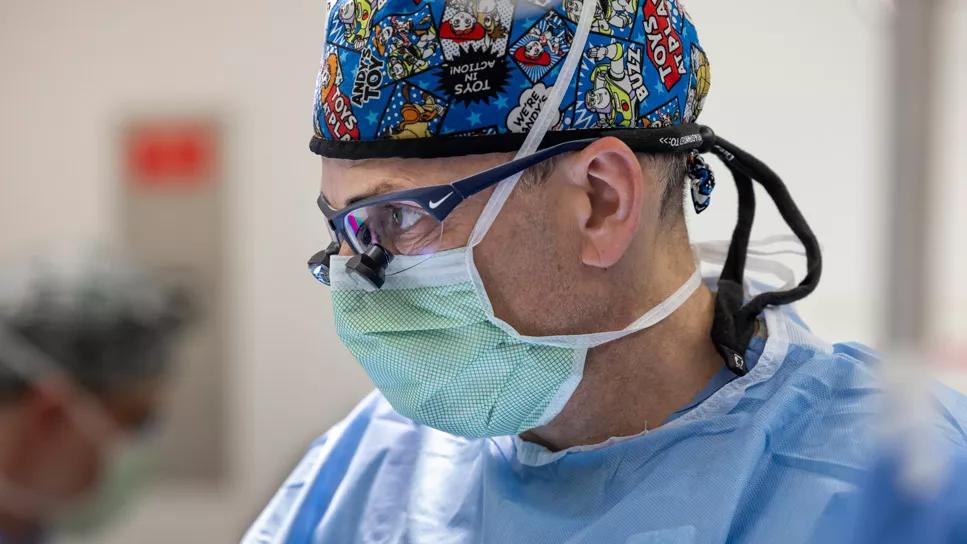Our new head of pediatric general and thoracic surgery shares his passion and vision

Miguel Guelfand, MD, has an ambitious goal as the new section head of pediatric general and thoracic surgery at Cleveland Clinic: “We want to be one of the top 10 U.S. centers in general pediatric surgery within the next 10 years.”
Advertisement
Cleveland Clinic is a non-profit academic medical center. Advertising on our site helps support our mission. We do not endorse non-Cleveland Clinic products or services. Policy
Dr. Guelfand is poised to lead. He is a trailblazer in pediatric and neonatal minimally invasive surgery (MIS), launching an MIS practice at Exequiel González Cortés Children’s Hospital in his home country, Chile, and creating curriculum as program director of the pediatric and thoracic surgery fellowship at the University of Chile.
During his 25-year career, Dr. Guelfand has trained and worked on four continents — Australia, Europe, South America and now North America — providing him with wide-ranging clinical experience and the opportunity to network with global experts.
“Being exposed to a broad spectrum of health systems, surgeons and cultures has made me a better surgeon and leader,” he says. “I have learned innovative ways to approach different pathologies, developed a broad skill set and increased my knowledge. If I need advice or come across a difficult case, I can consult with peers around the world.”
Prior to joining Cleveland Clinic, Dr. Guelfand was chief of pediatric surgery at Clínica Las Condes and president of the International Endosurgery Group. He has presented more than 70 international lectures on pediatric surgery and serves on the editorial boards of the Journal of Laparoendoscopic & Advanced Surgical Techniques, Journal of Pediatric Surgery and Surgical Innovation.
In this Q&A, Dr. Guelfand shares his passion for MIS and vision for pediatric surgery at Cleveland Clinic.
Q: What attracted you to Cleveland Clinic?
Dr. Guelfand: Joining Cleveland Clinic represented a unique opportunity to contribute to a transformative period in pediatric surgery. The prospect of being part of a team dedicated to setting new standards in healthcare excellence was particularly compelling.
Advertisement
We have grown to a team of six experienced pediatric surgeons here at Cleveland Clinic, and we plan to expand further by hiring two more specialists within the next year — one more expert in MIS and another in surgical oncology and solid organ transplant.
Q: What are your plans to help Cleveland Clinic become a national leader in pediatric surgery?
Dr. Guelfand: Our goal is to elevate Cleveland Clinic as a beacon of excellence in pediatric surgery, building on our established programs in fetal surgery, chest wall deformities and inflammatory bowel disease. We’re excited to introduce new initiatives focused on a comprehensive pediatric colorectal and pelvic center, a neonatal MIS program, and a pediatric surgical oncology and solid organ transplant program.
Also, through expanding our academic presence and organizing specialized conferences this year in chest wall deformities and neonatal surgery, we have committed to creating a collaborative space that promotes the sharing of knowledge and fosters ongoing learning among our peers.
Q: Why are you such an advocate for neonatal MIS?
Dr. Guelfand: Surprisingly, less than 10% of hospitals in the U.S. are doing MIS in neonates. Actually, it’s less than 6% for some pathologies. That’s striking. Even in advanced healthcare environments, providers are still performing open surgery when we can offer the same care with microincisions.
My passion is performing surgery with as little impact on the patient as possible. The underutilization of MIS in neonates in the U.S. is a significant concern. My commitment lies in advocating for and implementing MIS techniques that minimize patient discomfort and accelerate recovery, ensuring the highest standard of care for our youngest patients.
Advertisement
Q: When did you realize you wanted to pursue a career in this specialty?
Dr. Guelfand: My initial interest in cardiology shifted dramatically after experiencing the immediate impact of surgical interventions during medical school. The ability to do something on the spot — to use my hands and fix things right away — was very appealing to me. Soon after, I was introduced to pediatric surgery, and I realized that I wanted to be surrounded by the littlest patients. The allure of pediatric surgery became undeniable, driven by the profound sense of purpose in improving the lives of children and the collaborative ethos that pervades pediatric healthcare.
Q: In addition to your work as a surgeon, you’ve been a professor of pediatric surgery at various universities and presented dozens of invited lectures. Why is your work in academia important to you?
Dr. Guelfand: There are two main reasons. First, I have attended all kinds of conferences, which has introduced me to new research, innovative techniques and approaches related to my field. That provides me with more knowledge and better tools for my patients. Every time you listen to a presentation or interact with another surgeon anywhere in the world, you learn about something you should be doing — or, equally important, something you should stop doing. Sharing knowledge is important!
Second, it’s important to me that Cleveland Clinic be recognized not only in surgery, but also in academia. It’s a sign that we are committed to pediatric surgery. We are here to do research, expand the base of knowledge in our field and improve the care of our patients.
Advertisement
Advertisement
Advertisement

Center touts the benefits of neonatal MIS, trains others on the approach

Applications, outcomes and untapped potential

Quality improvement project addresses unplanned extubation

Least-invasive open-heart AVR option to date yielded rapid recovery in all cases

Specialized clinic provides comprehensive care for pediatric patients with a high-risk history

How one simple project changed the conversation about care and the patient-parental experience

First single-port renal vein transposition reduces recovery time and improves outcomes

Rare pregnancy complication can lead to fetal demise